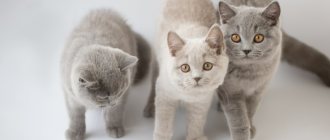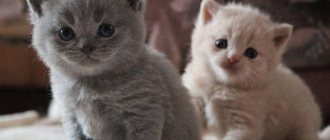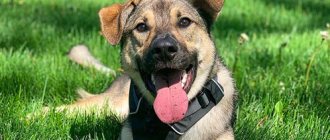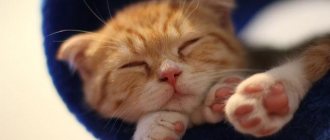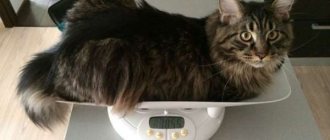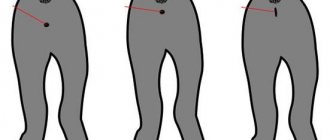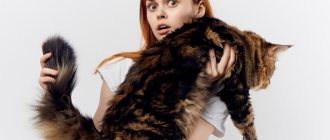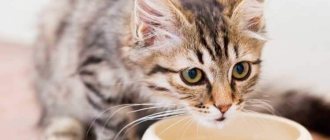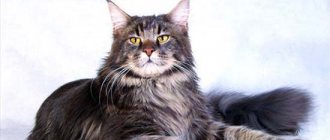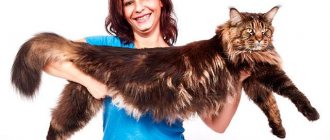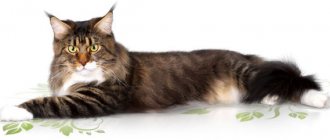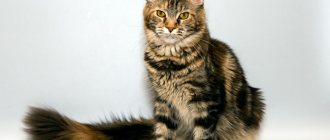16428Marina Kharlova
1
Maine Coon and an ordinary cat have many differences, however, the market is filled with a huge number of kittens that are passed off as real purebreds. In fact, at best it will turn out to be a mestizo - a cross between a Maine Coon and an ordinary cat, or it will even turn out that the Maine Coon was not even close to that.
In order not to make a mistake in choosing, you need to clearly know the characteristics characteristic of this breed. Before you go for the long-awaited kitten, it is worth studying in advance how the Maine Coon and an ordinary cat differ.
The handsome Maine Coons, with their appearance and large size, are more reminiscent of a real wild animal than a pet, due to which the demand for representatives of the breed has been steadily growing in the last decade.
© shutterstock
Appearance
First of all, you need to pay attention to the appearance of the kitten. The body parameters of the Maine Coon differ significantly from the sizes of ordinary cats.
Weight and size depending on age
From birth, Maine Coon kittens weigh 1.5 times more than their outbred relatives. At birth, a purebred baby weighs 120-150 g. While an ordinary cat weighs 70-100 g. By 2 months, a Maine Coon weighs about 1 kg. At 3 months, the weight of a purebred kitten is 1.5-2.3 kg. By 4 months, the baby’s body size is comparable to that of ordinary adult cats. Its weight ranges from 3-4.5 kg, and its body length can reach 50-60 cm.
Breeders have developed a special formula to determine the purebred of a Maine Coon depending on its weight. The age of the kitten in months must be divided by 2. The weight of a purebred animal cannot be less than the result obtained.
Body type
The build of Maine Coon kittens is strong and stocky. Purebred pets differ from ordinary babies:
- long body;
- large powerful paws;
- elongated head;
- clearly defined cheekbones;
- square chin;
- broad chest;
- powerful neck;
- heavy skeleton.
Immediately after birth, these signs are less pronounced. Therefore, it is recommended to buy a Maine Coon kitten at the age of 2.5-3 months.
Often closer to 3 months, Maine Coon kittens actively develop their skeleton. Therefore, the baby may look thin and awkward. This is normal and your pet will gain weight with age.
Wool
The fur of small Maine Coons is much longer and softer than that of a regular kitten. It is pleasant to the touch, silky, and has a satin shine. Starting from 3-4 months, characteristic fluffy “pants” appear on the hind legs. Babies also begin to grow a fluffy mane, which is fully formed by the age of six months. Most purebred kittens grow fur between their toes.
The fur between the paw pads is necessary for walking on snow in natural conditions. The hairs increase the area of contact of the paws with the snow cover, thereby allowing them to literally glide across its surface.
Regular kittens' fur is the same length all over their body. While in purebred babies it grows unevenly. The head and paws are covered with short, dense fur. And long hair falls from the back and sides.
In addition to the length of the coat, its color is of great importance. Pedigree kittens come in the same colors as outbred kittens. With some exceptions. Purebred Maine Coon cats cannot have color point, cinnamon, fawn and chocolate colors. Moreover, these colors should not appear in combined coloring.
Useful: “Maine Coon weight and size by month.”
Why does a Maine Coon kitten not gain weight?
As soon as the owner notices a discrepancy with the body weight table, it is worth seeking help from veterinarians. Insufficient recruitment can be caused by a number of reasons:
- lack of vitamins;
- non-compliance with energy balance;
- the kitten is stressed;
- genetic or acquired diseases of the kitten.
If a cat gives birth to small newborn kittens, they may develop more slowly and take longer to reach the required weight and body size. Larger ones develop much faster than their smaller peers. Small size is often due to genetics.
Sometimes there are situations when just small kittens are born. This can be called a genetic failure; it cannot be corrected. You should not give your kitten any supplements that affect growth on your own. All drugs should be prescribed only by a veterinarian and if there are compelling reasons for their use.
Special characteristics of the breed
The Maine Coon breed is distinguished by several characteristic, pronounced features that are not found in ordinary cats:
- Tassels on the ears, like a lynx. They usually appear by three months of age. If the tassels have not formed by 4 months, then most likely they will no longer exist.
- Wide, high-set ears. They stand upright, there is no tilt towards the head. The distance between the ears corresponds to the width of the ear at the base. In adult cats, this figure may increase. Thick horizontal hairs grow on the inside of the auricle - peculiar brushes that perform the heating function.
- A serious, menacing look thanks to large, slightly slanted, almond-shaped eyes.
- The profile has a square shape. While a simple cat’s muzzle is neatly rounded.
- Large tail covered with long hair. In Maine Coon kittens, the tail easily reaches the shoulder blades, in some individuals it reaches the neck. The length of adult cats is 55-60 cm.
- Stiff and long mustache that feels like a fishing line. Their length reaches 18 cm. The whiskers of outbred cats are much softer.
The listed features are most pronounced in adult Maine Coon cats. However, by 3 months they are clearly visible in kittens. Experienced breeders still do not sell younger babies.
Interesting: “How long do Maine Coons live?”
Features of feeding
The health of Maine Coons depends 80% on nutrition; when compiling a diet, the following rules are adhered to:
- The type of feeding is chosen from childhood and is not changed or mixed in the future.
- With natural nutrition, the diet is closer to natural: 75% is lean meat, offal, ground poultry necks, the rest is vegetables and dairy products. Once a week add boiled sea fish and egg yolk.
- Soft food destroys teeth, so the meat is not minced, but cut into pieces.
- Among industrial feeds, choose lines designed for large breeds. They add components to strengthen joints, and enlarge the granules so that the cat does not immediately swallow, but chews the food.
- Kittens up to 4 months old are given food 5-6 times a day; by the time they reach the age of one year, the number of feedings is gradually reduced to 2 times a day in the morning and evening.
- Bowls for drinking and food are placed at a distance so that splashes of water do not get into the food.
Here are examples of dry food for large cats:
- Bozita Feline Funktion Large is created on the basis of dehydrated chicken and fresh salmon, the total amount of proteins is 31%. The food contains useful additives: chondroitin, glucosamine support joints, Omega 3-6 fatty acids strengthen skin and coat, L-carnitine improves metabolism, MacroGard complex strengthens the immune system.
- Bosch Sanabelle Grande contains 31% protein. To support the joints, mussel flour is added, to strengthen the coat - flax seed, yeast, and fish oil.
- Royal Canin includes two varieties for Maine Coons: for kittens up to 15 months and adult cats. Feed is created from dried poultry meat. Hydrolysates from cartilage and crustacean shells strengthen bones, plantain seeds stimulate the removal of hair from the stomach, and prebiotics normalize intestinal microflora.
The Maine Coon will become a devoted friend if the owner is willing to devote time to the pet: raising, playing, caring for it.
Character and behavior
The external distinctive features of the Maine Coon are immediately noticeable. But in order to avoid deception, you need to know about the behavior of purebred cats. The Maine Coon breed is characterized by the following habits:
- Passion for cleanliness. Maine Coons, unlike other felines, are not afraid of water. And they enjoy water procedures.
- Mainly living in one favorite place in the house. Cats of this breed love comfort and prefer to spend most of their time in their favorite corner.
- Good attitude towards children. A large cat can often be found frolicking and playing with a child. At the same time, the pet will never harm the baby.
- High physical activity - love for active games, pranks, and performing various tricks.
- Singling out only one person as the master and recognizing his full authority.
Maine Coons have a high level of intelligence compared to other cats. Representatives of this breed are easy to train and are able to carry out simple commands (come to me, give me a paw, sit, lie down).
Despite their menacing appearance, Maine Coon cats have a soft character. They are considered family pets. Pets of this breed are affectionate, have a stable attachment to family members, willingly make contact, and allow themselves to be petted. Maine Coons enjoy spending time with people. Unlike mongrel cats, they do not like loneliness and prefer to be in the company of family members.
Maine Coon cats are also very curious. Pets are constantly interested in what is happening around them, climb into secluded corners of the house, and come up with new activities. Therefore, their owners need to be extremely vigilant. Representatives of this breed land poorly when falling from a height and often get injured or even die while exploring the world around them.
Cat or cat?
To begin with, of course, you need to decide - is it a cat or is it a cat?
In fact, most often people choose a cat and there is an explanation for this. Firstly, they grow larger than cats. Secondly, cats have a softer character. This does not mean that cats are angry and aggressive, it’s just that cats are calmer and after three to four years they prefer to lazily lie on the sofa as a beautiful decoration.
Cats, on the other hand, are active, playful and need physical activity throughout their entire lives. When choosing the sex of an animal, you should take into account what you want to get - a beautiful couch potato or an active toy.
In addition, according to some beliefs, cats take energy, and cats, on the contrary, heal. Here, of course, it is difficult to refute or, conversely, to assert, since these are just beliefs without any evidence. Although, if a person is superstitious, perhaps this argument will play a decisive role in choosing the sex of the furry.
Documentation
Even if all the external signs and character of the kitten indicate that it absolutely belongs to the Maine Coon breed, you should not rush into the purchase. The terms of the transaction play an important role. A conscientious, responsible breeder will never hand over a kitten to a buyer without the appropriate documents:
- An agreement that will necessarily specify the age of the kitten, its external characteristics, the timing of its transfer to the new owner, and whether it has age-appropriate vaccinations and medical examinations.
- Veterinary passports with marks on the medical procedures completed.
- Pedigree. The document contains information about the baby’s parents and other information confirming his origin and belonging to the Maine Coon breed. Also in the pedigree there is a mark indicating that he is enrolled in one of three groups - Show, Breed or Pet.
Representatives of the first group have excellent exhibition characteristics. Breed cats have a good genotype and are suitable for professional breeding work. Pets from the Pet group are suitable for breeders who do not plan to travel with a cat to exhibitions or breed animals.
Interesting: “How to choose a Maine Coon kitten.”
How to distinguish a Maine Coon kitten from a regular one is a common question among novice breeders. Before purchasing, you need to be well prepared, study the external characteristics of the breed, as well as the habits of large cats. Then the probability of getting a purebred kitten will approach 100%.
Owner reviews
“I dreamed of a Maine Coon for several years, but ordinary cats lived with me all my life. But a couple of years after the arrival of the long-awaited kitten, I greatly regretted it. I can’t stop him from climbing tables and cabinets and stealing food. Wool is everywhere, I no longer have the energy to clean it up. Food expenses are quite significant, and the tray takes up half of the hallway. So he also digs like an excavator, scattering the filler. He destroyed all my repairs - not only with his claws, he also likes to chew on everything, especially wires. I changed the curtains several times, they were all torn. So think before you adopt a Maine Coon – all the problems that can be associated with cats will have to be multiplied by three.”
“Tyson looks menacing and looks angry, but in reality he won’t offend anyone. He doesn’t recognize tenderness, he keeps his distance, but he always comes to bed and can almost lie on his head. Smart, noble, but not arrogant. Ideal!"
“I adore my kunator, but my Timofey is such a pig! He always scatters food around the bowl, and he also likes to scoop up water with his paws. He doesn't go to the potty carefully, I clean his fur pants every day. Everyone's tail catches garbage. Another peculiarity is that he constantly takes funny poses! At first I constantly ran after him with a camera. When he sleeps, it’s absolutely something. A favorite of the whole family, all pranks are forgiven."
“My husband is sure that our cat understands human speech. She often pesters us to play, even though she is already 3 years old. I don’t understand the worries about fur – what did you want from a long-haired cat? Tosya is no more troublesome than an ordinary cat, our pride and joy. We were choosing between Maine Coons and Norwegians, we are very glad that we finally got a Maine Coon.”
“The cat never scratched my little daughter, although she periodically pestered him. If he doesn’t like something, he simply goes to the top (they made him a cool climbing complex). Maintenance costs about 5 thousand a month, which may seem like a lot to some, but it’s normal for us, we knew what we were getting into. When guests arrive, at first everyone talks only about the cat, he attracts everyone’s attention.”
What determines the red color of a kitten?
The scientific name for cats with a red color is red, otherwise - with the orange gene (O). Females and males are carriers of 2 sex chromosomes. For the former they are designated as XX, for the latter – XY. The gene responsible for the red coat color is located on chromosome X.
Because cats only have one X chromosome, they can be completely black or red. Male tortoiseshells are very rare among representatives of this family. If they are born with this color, they usually turn out to be sterile.
At conception, the fetus receives one chromosome each from its mother and father. He takes X from his mother, X or Y from his father. As a result of the combination of maternal X and paternal X, a girl is born. If X mother and Y father meet, a boy is born. The baby always receives color from the mother, and from the father only if he passes on the X chromosome to the baby.
Based on the above, we can conclude that:
- the birth of a red kitten is possible from parents of the same shade;
- if mom’s fur is red and dad’s is black, a ginger kitten or tortoiseshell cat will be born;
- A black female and a red male give birth to tortoiseshell girls and black boys.
Tortoiseshell cat
Tortoiseshell cats can produce offspring of different colors. When mating with black cats, they give birth to black or tortoiseshell girls and red or black boys, with red cats - red or tortoiseshell babies and black babies. Knowing this, it is possible to predict with high accuracy what color wool the heirs of specific parents will have.
Best Help with advice on buying a Yorkie
Diseases
Since the breed was formed in wild conditions, modern representatives have inherited physical strength, excellent endurance and good health from their Aboriginal ancestors. However, among them there are individuals with one or another pathology - both congenital and acquired.
Serious pathologies characteristic of Maine Coons include the following diagnoses:
- Hip dysplasia. This is explained by its underdevelopment. Accompanied by pain, instability, and immobility of the animal.
- Hypertrophic cardiomyopathy. Is a genetic defect. It is expressed in disruption of the functioning of the heart muscle. The disease has no visible signs and can be fatal.
- Spinal muscular atrophy. It has a genetic nature. Accompanied by complete muscle atrophy, shortens life expectancy.
Less dangerous disorders that are common to representatives of all breeds include:
- digestive disorders;
- formation of stones in the kidneys and urinary tract;
- skin diseases;
- dental diseases;
- parasitic infections.
Origin story
The history of the origin of all native cat breeds, including the giant Maine Coons, is shrouded in legends and myths.
The first hypothesis about how this breed appeared dates back to the times of the Vikings, when they conquered new lands. In the year 1000, warriors traveled on their boats to the New World, and with them the ancestors of Norwegian forest cats got there. However, the Vikings were soon forced to return to the old continent. But the cats stayed for a long time, and as a result of crossing with local cats, the Maine Coon appeared.
The second version dates back to the time of the French Revolution, when Queen Marie Antoinette planned her escape from Paris (1793). She sent her cats to Captain Samuel Clough's sailing ship in advance. The couple of monarchs did not manage to leave France, but the animals safely reached the shores of the United States in Maine. There the cats received new blood from local animals, which became the basis for the formation of a new breed.
Another legend says that Maine Coons are the offspring of a domesticated cat and a wild Manx raccoon.
Objective data about Maine Coons appeared only at the beginning of the twentieth century, when “The Book of the Cat” by the American Frances Simpson was published in 1903. In it, the author described in detail both her own pets and the animals that belonged to her friends. The beginning of the story dates back to 1861, which became the main starting point in the biography of this extraordinary breed. Then there are almost no blank spots left in the Maine Coon chronicle:
- Beginning in 1860, Maine farmers exhibited local cats during the annual fair.
- Most of all, Maine Coons were valued not for their external qualities, but for their incomparable ability to hunt rodents - the large cat easily coped with the invasion of mice in grain barns.
- In 1895, 12 Maine Coons took part in the first national North American show - the cat Cozy from Maine was named the winner of this show.
Then history made an unpleasant zigzag - in the twentieth century, the large Maine Coon breed was almost destroyed by the expansion of the Persians and Turkish Angora cats. In 1911, the aborigines took a prize for the last time at an exhibition in Portland and disappeared from the field of view of felinologists for 40 years.
The big cats were rescued in the same place where their lineage began - in the agricultural regions of America. Farmers were indifferent to fashion trends, but they were concerned about the safety of the crop. So the Maine Coons did what they knew how to do best - catch rodents.
In 1976, the breed was completely restored, it returned to international exhibitions and from that time on never disappeared. Another 9 years later (1985), Maine Coons were recognized as the official state cat of Maine.
White
Of course, pure red cats and cats look absolutely gorgeous. However, red animals with white spots also look very good. This coloration is allowed by the standards of many breeds. Where does the white color come from on animal fur? After all, only one gene, red/black, is responsible for color in cats.
Animal fur gets its color from the pigment contained in the hairs. Phaumelanin gives the red tint to cat fur, and eumelanin gives the black tint. The white color of the coat of such pets is formed due to the presence of hairs that are completely devoid of pigment.
A special gene S is responsible for the presence of such spots in the color of cats and cats, including red ones. In animals, it can be present on the chromosomes as SS, Ss or ss. Depending on this, the pet will be almost completely white, with white spots, or completely red (black, tortoiseshell).
